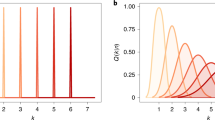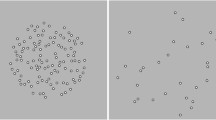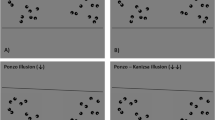Abstract
It has been claimed that empirical work in psychology requires the attribution of representational content to perceptual states: that is, the attribution of veridicality conditions to those states. This is a claim that can only be evaluated by the examination of actual empirical research. In this paper I argue that talk of ‘representation’ in at least one area of research in the psychology of perception can be reinterpreted so as to avoid the attribution of veridicality conditions. This area is the study of human capacities to perceive the relative numerosities of collections of objects.

Similar content being viewed by others
Notes
See (Burge 2005) for a recent version of this complaint.
In terms familiar from Chisholm (1957), an epistemic look presented by the cloud is explained by a non-epistemic look: because of the dark (non-epistemic) look of the cloud, I have perceptually-derived reason to believe that it is likely to rain.
This describes an experiment by Durgin (1995).
References
Austin JL (1962) Sense and sensibilia. Oxford, Clarendon
Block N (1990) Inverted earth. In: Tomberlin J (ed) Philosophical perspectives, vol 4. Ridgeview Publishing Co, Atascadero 33: 1–78
Burge T (2005) Disjunctivism and perceptual psychology. Philoso Top 33: 1–78
Burr D, Ross J (2008) A visual sense of number. Curr Biol 18: 425–428
Burr D, Ross J (2012) Number, texture and crowding. Trends Cogn Sci 16(4): 196–197
Chisholm R (1957) Perceiving: a philosophical study. Cornell University Press, New York
Durgin F (1995) Texture density adaptation and the perceived numerosity and distribution of texture. J Exp Psychol Hum Percept Perform 21: 149–169
Durgin F (2008) Texture density adaptation and visual number revisited. Curr Biol 18: R855–R856
Frege G (1892) Über Sinn und Bedeutung. Zeitschrift für Philosophie und philosophische Kritik 100: 25–50
Peacocke C (1992) A study of concepts. MIT Press, Cambridge
Pelli DG, Tillman KA (2008) The uncrowded window of object recognition. Nat Neurosci 11(10): 1129–1135
Author information
Authors and Affiliations
Corresponding author
Rights and permissions
About this article
Cite this article
O’Sullivan, M. Number and Illusion: Representation and Numerosity Perception. Topoi 36, 311–318 (2017). https://doi.org/10.1007/s11245-014-9277-0
Published:
Issue Date:
DOI: https://doi.org/10.1007/s11245-014-9277-0




